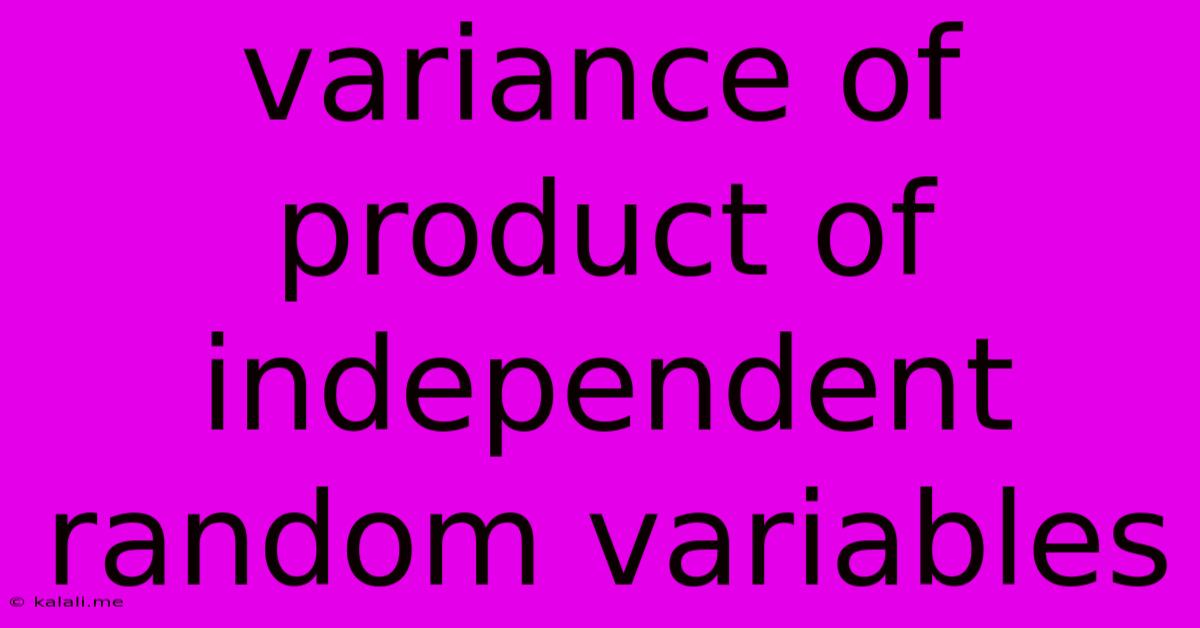Variance Of Product Of Independent Random Variables
Kalali
May 24, 2025 · 3 min read

Table of Contents
Variance of the Product of Independent Random Variables
Understanding the variance of the product of independent random variables is crucial in various statistical applications, from financial modeling to signal processing. While the expected value of the product is simply the product of the expected values (due to independence), calculating the variance is significantly more complex. This article will delve into the derivation and application of this concept.
What are Independent Random Variables?
Before we dive into the variance calculation, let's briefly define independent random variables. Two random variables, X and Y, are considered independent if the outcome of one does not influence the outcome of the other. Mathematically, this means their joint probability distribution is the product of their individual probability distributions: P(X=x, Y=y) = P(X=x)P(Y=y).
Deriving the Variance
Unlike the expected value, there's no simple formula for the variance of the product of two independent random variables. The variance of the product, denoted as Var(XY), requires considering the covariance and higher-order moments. Let's break down the derivation:
Let X and Y be two independent random variables. We want to find Var(XY). Recall that Var(XY) = E[(XY)²] - [E(XY)]².
-
E(XY): Since X and Y are independent, E(XY) = E(X)E(Y).
-
E[(XY)²]: This is where it gets tricky. We can rewrite this as E[X²Y²]. Because X and Y are independent, we can separate this expectation: E[X²Y²] = E[X²]E[Y²].
Therefore, we can express Var(XY) as:
Var(XY) = E[X²]E[Y²] - [E(X)E(Y)]²
This formula uses the second moments (E[X²] and E[Y²]) of the individual random variables. We can express these second moments in terms of the variance and expected value using the following relationship:
E[X²] = Var(X) + [E(X)]²
Substituting this into our variance formula, we get a more complete expression:
Var(XY) = (Var(X) + [E(X)]²) (Var(Y) + [E(Y)]²) - [E(X)E(Y)]²
This expanded form illustrates how the variance of the product depends on both the variances and expected values of the individual random variables.
Example:
Let's consider a simple example. Suppose X and Y are independent random variables with:
- E(X) = 2, Var(X) = 1
- E(Y) = 3, Var(Y) = 4
Using the formula derived above:
Var(XY) = (1 + 2²) (4 + 3²) - (2 * 3)² = (5)(13) - 36 = 65 - 36 = 29
Therefore, the variance of the product XY is 29.
Generalization to Multiple Variables:
The concept can be extended to more than two independent random variables. However, the complexity increases significantly with each additional variable. The general formula becomes computationally intensive for a large number of variables. Numerical methods or approximations may be required in such cases.
Applications:
The variance of the product of independent random variables has wide-ranging applications in various fields, including:
- Finance: Modeling portfolio variance, where asset returns are often treated as independent random variables.
- Signal Processing: Analyzing the variance of the product of signals, especially in noise reduction techniques.
- Physics: Characterizing the uncertainty in the product of measured quantities.
Conclusion:
Calculating the variance of the product of independent random variables is more complex than simply multiplying the individual variances. The derived formula highlights the role of both variances and expected values in determining the overall variance of the product. Understanding this concept is crucial for accurate modeling and analysis in numerous applications across diverse fields.
Latest Posts
Latest Posts
-
How To Tell What Version Of Minecraft You Have
May 25, 2025
-
Substitute For Dry Milk Powder In Bread
May 25, 2025
-
Where Did Moses Write Of Jesus
May 25, 2025
-
Rip In The Fabric Of Time
May 25, 2025
-
Dishwasher Backing Up Into Garbage Disposal
May 25, 2025
Related Post
Thank you for visiting our website which covers about Variance Of Product Of Independent Random Variables . We hope the information provided has been useful to you. Feel free to contact us if you have any questions or need further assistance. See you next time and don't miss to bookmark.